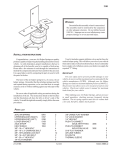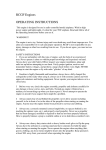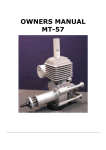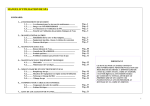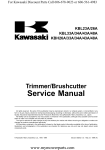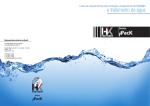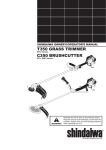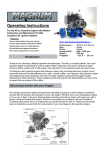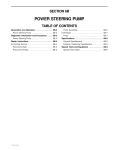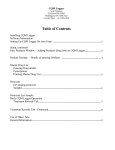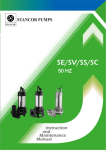Download RCGF ENGINE OPERATIONS MANUAL
Transcript
RCGF ENGINE OPERATIONS MANUAL Introduction To RCGF Engines Congratulations to your purchase of this RCGF Engine. You have in your possession one of the strongest and most powerful engines in its class today. RCGF Company is the professional manufacture which design and produce various of RC model fittings and gas engines, especially in model aircrafts. Now we have the high quality RCGF engines from 15cc to 220cc which can meet your different demands. RCGF Engines provides the Giant scale aircraft pilot the power, and performance features necessary so you can fly with confidence. Our line up of engines are designed and engineered for RC giant scale aircraft. All our engines are modeler tested across the world. Real world results shape the engines. Performance is your reward The RCGF engines are built to a high level of quality, and are engineered to provide years of trouble free service. It is important for you to go through the manual to familiarize yourself with the engine and how its operations. Contact us via email or telephone if you have any questions. We are here to help you enjoy your engine. Safety Instructions LISTEN UP!! IMPORTANT SAFETY INFORMATION FOR THE USE OF RCGF ENGINES WARNING! This motor can cause severe harm to you, and/or others, if misused or if these safety precautions and instructions are not observed. RCGF Engines is not responsible for any loss, injury or damage resulting from the use of its products. ▀ Read all the instructions before operating your engine. ▀ If you have any questions about any aspect of operating the engine, do not at tempt to start or operate it in any way. ▀ You, and only you are responsible for the safe operation of your engine. ▀ Do not operate the engine if you do not want accept complete responsibility for any injury or damage caused or incurred during its operation. ▀ Verify proper ignition, receiver and transmitter battery voltages, and perform a range check before every flight. ▀ Never operate the engine or fly model aircraft alone. ▀ Turn the engine off before making any adjustments. ▀ Prior to operating the engine inspect motor mount bolts and firewall integrity. ▀ Eye protection should be used by all persons in the immediate area of the engine when the engine is running. ▀ Ensure the aircraft is properly secured when starting or operating the engine as it can develop tremendous thrust. ▀ Operate the engine in an open area. Never operate indoors. ▀ Always stand behind the propeller when operating the engine. ▀ Use a heavy duty starter stick, or a properly sized electric starter to flip and/or start the engine. Use heavy leather work gloves when flipping the prop. ▀ Stay away from the prop while operating the engine. Do not wear loose clothing near the engine or prop. Do not allow people to stand in front or beside the propeller when the engine is operating. ▀ Do not run the engine near loose material such as dirt, sand, gravel, power, ropes, cords, etc. Any loose material can be drawn into the turning prop causing injury or damage. ▀ Keep people and pets at least 50 feet away when operating the engine. ▀ Always use the proper size propeller. Never use damaged, modified or repaired propellers. ▀ Always use the correct type and length of propeller bolts. Never use spacers behind the propeller. ▀ The spinner cones must not touch the propeller. ▀ Some thinner props may require the use of shorter prop bolts, especially if not using a spinner back plate. Ensure your prop bolts do not bottom out in the propeller hub. ▀ Check that the propeller bolts are tight before every flight. ▀ Always install an ignition kill switch to stop the engine. ▀ Carburetor linkages should be adjusted so that the engine will stop when the carburetor is completely closed. ▀ Gasoline is extremely flammable. Do not smoke in the area of your engine and gas supply. Also sparks can come from electrical contacts on fuel pumps, battery chargers, and other support equipment. Always have a fully charged fire extinguisher nearby and ready. ▀ Fuel your aircraft when the engine is cool to the touch. ▀ After running your engine, turn your prop several revolutions. This will ensure that your ignition system is discharged. ▀ Never turn the engine over without ensuring the ignition system is off. ▀ The Ignition system develops high voltages. Never touch it during operation. ▀ Always fly in accordance with the safety runs, regulations and recommendations of the AMA (American Modeling Association). Read and understand all of the safety material on their website www.modelaircraft.org before using this engine. In Canada, the representing body is MAAC (Model Aeronautics Association of Canada) and their website is www.maac.ca Engine Installation If using mounting brackets, they should be installed with the closed end to the firewall and the open end to the engine.If using the mounting stand-offs, the cut ends should be mounted to the engine. If additional mounting height is needed, it should be placed between the mounting hardware (brackets / stand-offs) and the firewall. Make sure that all spacing is flat and of the same size and surface plane so as not to induce any twisting force into the mounting hardware or damage to the engine or mounting hardware failure may result. Spacing should never be used between the mounting hardware and the engine. In all cases, the firewall / airframe mounting surface must be absolutely flat or potentially damaging forces can be exerted to the engine or mounting hardware which can cause failure. Check to see that the carburetor has adequate clearance (at least 1in.) to anything for proper breathing. If it doesn’t, make appropriate adjustments. Make sure that your airplanes fuel tank and lines are made for gasoline use, that the tank is adequately vented and that the feed line clunk can move freely in all directions and not get hung up anywhere. We recommend using a filter between your gas supply and airplane fuel tank. If you use a fuel filter between the airplane tank and the carburetor, make sure it is of adequate size to supply an unobstructed flow of fuel to the carburetor the engine may not run correctly. Make sure that the cowl openings on your plane provide enough airflow for proper cooling. Ideally, all of the cooling fins of the cylinder should be exposed directly to unobstructed flow of cooling air and there should be 3 times as much air exit area as intake area. Many planes have cowl openings that actual y inhibit proper cooling of single cylinder engines. Their openings were made to give a scale appearance of the full size planes they are patterned after. Along with the openings described above, blocking the scale openings either partially or wholly can significantly help promote cooling airflow over the cylinder fins. Many types of fuelling devices (fuel dots, filler valves, etc.) are available for your use. Our experience has shown that often the simplest is the best. Regardless of which device you decide to use, be very wary of air leaks, as they can be detrimental to the proper operation of your engine. NOTE: Always use Loctite on engine mounting hardware and make sure your models firewall and engine box are adequately reinforced (pinned, soaked in thin CA, etc.). Engine Break In Break in running should be done with regular 90 octane gas mixed with a high quality petroleum based 2 cycle oil at a ratio of 30:1. The engine should be run installed in the airframe with wings attached, on the ground for at leat 20 minutes at 2500rpm. Ground running should be done with a slightly smaller prop and with the cowl off to promote good cooling. It is not recommended that you run the engine in a test stand, as they do not allow vibration energy to be properly dissipated. Plus, it is not needed. Your engine is ready to go. During the break-in process (a couple of gallons of gas) the carburetor may need to be adjusted and the engine should be flown at light load and varying speed for enough time to have the oil/gas run through it. After you have run a couple of gallons of fuel through, you can switch to a full synthetic 2 cycle oil mixed at a ratio of 50:1. Note that when you switch to synthetic 2-cycle oil, it is likely that the carburetor mixture and idle speed will need to be adjusted. We recommend high quality synthetic 2 cycle oil. Never use outboard motor 2 cycle oil. Carburetor Adjustments Every engine has been adjusted to average mixture settings, which will most likely allow the engine to start and run in most locations. However, as altitudes and barometric pressures vary by location and even by day, it is very likely that the carburetor mixture settings will need to be adjusted to obtain optimum performance. NOTE: A. Never make adjustments to the carburetor while it is running. Always use a tachometer to aid in making adjustments to your carburetor. B. Do not remove the carburetor spring (2) as the spring helps keep the carburetor butterfly aligned properly. Merely release the ends of the spring so that it no longer holds the butterfly closed. 1 2 3 4 5 6 Choke Lever Throttle Lever Idle Speed Adjustment Screw Low Speed Mixture Adjustment Screw High Speed Mixture Adjustment Screw Ignition Sensor The average mixture settings are 1&1/4 turns out for the low speed circuit (See No. 4), and 1&3/4 turns out for the high-speed circuit (See No. 5). Carburetor mixture adjustment starts with the low speed circuit. The low speed should be set such that the transition from idle to full throttle is smooth, even if the throttle is snapped to full. This will likely result in a slightly rich idle mixture but you’re better off with that than a rough transition. If the engine dies when the throttle is advanced, the mixture is likely too lean. If the engine stumbles when the throttle is advanced, the mixture is likely too rich. Since the low speed mixture has some effect on high-speed mixture, always adjust the high speed after adjusting the low. The high-speed circuit is properly adjusted when the engine can reach maximum rpm while in the air, which is usually slightly richer than when it is on the ground. A general rule of thumb is to richen from the maximum on the ground rpm by about 200rpm. If ever the engine slows or dies while at full throttle, the high-speed mixture is likely too lean and you should adjust it as soon as possible or damage can result. NOTE: Be careful not to run the mixture screws in too far as damage to the screw and / or carburetor body may result. Also, don’t be tempted to run an overly rich mixture. Gas engine lubrication comes from the oil concentration in the gas, not from a rich fuel / air mixture. If you want more lubrication, you can vary the oil mix ratio. A too rich mixture will only result in poor engine performance and a fouled plug and combustion chamber. Starting the Engine COLD Step 1: Close the choke, advance the throttle to very slightly above the idle position, turn on the ignition and briskly flip the prop through compression until the engine fires and then dies. If the gas line is dry, this may take 20 or more flips. Step 2: Open the choke and briskly flip the prop through compression. The engine should start in just a few flips. If it acts like it wants to start but doesn’t, you may need to advance the throttle slightly. WARM Open the choke, advance the throttle to very slightly above the idle position, turn on the ignition and briskly flip the prop through compression. The engine should start in just a few flips. If it acts like it wants to start but doesn’t, you may need to advance the throttle slightly. NOTE: It is possible to flood the engine by over choking. In this case, the spark plug must be removed and dried of excess fuel. Make sure to have the ignition off when removing the spark plug. Engine Maintenance Fuel tubing throughout the fuel system should be changed periodically and should never allow any air to enter the system. If your gas line starts to get hard, soft or changes colour, there’s a good chance it needs to be replaced. Keep in mind that the tubing inside your tank deteriorates more quickly that anywhere else in the system. The exterior of the engine should be kept clean and inspected regularly. Tucked away inside the cowl, it would be easy to miss loose nuts and bolts without frequent inspections. Dirt inside the cowl area can easily find its way into the carburetor. It should be kept clean and free of dirt build up. The carburetor fuel screen should be cleaned periodically also. Carefully remove the pump cover (inlet side of the carburetor), gasket and pump membrane. The screen will be visible and can be cleaned after careful removal. If ever the carburetor seems to need frequent mixture adjustment or acts like it’s starving for fuel, a dirty screen is a likely candidate for a cause. The carburetor should be inspected, cleaned or reconditioned with every flying season or after being stored for a long period of time. The spark plug should be inspected, cleaned and gapped periodically and replaced if it is fouled or worn. A new plug with every new season is a worthwhile maintenance step. a) Before using the engine, please check the aircraft propeller and the engine frame etc. carefully in order to make sure the screws and nuts fixed. When you installed the engine, you had better use the screw glue ( such as LOCTITTE 242) to fix the screws or nuts. b) Please use the clean petrol 93#. The ratio of petrol and engine oil is 30:1;Carburetor will be seriously obstructed if the engine oil be mixed up with from different manufacturers or brand. c) If the engine is running in an idle speed too long, spark plug might be serious carbonized. d) Always check and secure the tube between the fuel tank and the carburetor, make sure there is no air leaking. e) Keep the surface of the engine clean. Be sure the engine is well heat dissipation. f) NOTICE: Please clean the fuel filter in the carburetor periodically, otherwise failure occurs with needle adjustment and the engine may work unsteadily etc. g) Take apart the screw, and open the rear cover of the carburetor. Wash the filter. Ignition System RCGF Ignitions Ver 2.0 INSTRUCTIONS 1.) Specifications I.)WARNING - RCGF ignitions were designed for use in model aircraft and should NEVER be used in a Human Carrying Vehicle!! II.)BPMR6F 14mm and BMR6A Ignition: III.) CM6 10mm and ME-8 1/4 32 Ignition: Input voltage 4.8-6v Input voltage 4.8-6v Output voltage 12-16 kV Output voltage 12-16 kV Max Draw @6000 rpm - 500 ma±5% Max Draw @6000 rpm - 500 ma±5% Case - ABS with Nickel plate Case - ABS with Nickel plate Weight Single: less battery - 4.4oz Weight Single: less battery – Single 4.4oz Weight Twin: less battery - 6.1oz Weight Twin: less battery - 6.1oz Plug size - 14MM NGK (BPMR6F) Plug size - 10MM NGK (CM-6) 2.) Selecting a Power Source I.)4.8 and 6v volt NiCd/NiMh Packs: The RCGF Ignition ver 2.0 is rated 4.8 to 6v a max of 7 volts. A 4 cell 4.8v pack and 5 cell 6v pack with a minimum of 800 mAh is fine and creates a hot spark. The RCGF ignition ver 2.0 runs most efficiently on 4 cell and 5 cell 6v pack . Do not use an old Pack!! If it’s not good enough for your receiver, it’s not good enough for your ignition.. If you use 4.8v packs the engines may not achieve its highest rated rotational speed. If possible use a 6V pack. II) 6.4 Volt Li-Fe(A123) Packs: 2cell Li-Fe(A123) - Max voltage of 7.2 volts. Nominal 6.6 Volts. The use of a voltage regulator is necessary III.) 7.4+ Volt Li-Poly Packs: 2cel Li-Poly Packs at peak charge can be as high as 8 +v. If you are going to use a 2 cell Li-Poly Packs, you must use a voltage regulator. The Rcgf ignition runs more efficiently between 4.8-6 Volts. Running the system with a higher voltage may also cause unwanted RFI interference to you radio system. Please do not use old packs to power your ignition! 3.) Installation I.) Spiral Wrapping: Use the supplied Spiral Wrapping included with your Ignition to protect the wires from heat and chafing. Wrap the braided Spark Plug Lead, Hall Sensor Harnesses and Battery Harnesses. II.) Mounting: Mount your Ignition on the engine box if possible. Wrap the ignition in foam to reduce the effects of engine vibration on the circuitry. You can use the mounting tabs on the ignition but we recommend using zip ties or Velcro ties to secure it. Do not install your ignition in the fuselage. Keep the ignition as far away from you receiver as possible and never use the same power source to run your ignition and receiver jointly. III.) Connecting the Battery: The RCGF ignition utilizes the Futaba style plug ends and comes with an additional pigtail to add to your ignition switch if necessary. Be sure to follow the color coding (Red +, Black -) when attaching your to your power source and on / off switch to your ignition power leads. Wrap your battery with foam and mount it as far away from the receiver as possible, preferably on the motor box. Note: There are no serviceable parts in the ignition system. Opening the case will void the engine warranty. 4.) Trouble Shooting your Ignition. I.) Battery: Check the voltage on your battery and make sure it’s healthy and fully charged. Insure that the voltage is 6v or less to the ignition. II.) Connections: Check that all connections are correct from the battery, to the switch, to the ignition. Use a volt meter on the switch to ensure the ignition is getting power and the polarity is correct. III.) Hall Effects Sensor: Ensure that the orientation of the hall sensor is correct with the orientation of your hub magnet. 5.) Safety Precautions. Never power the ignition with the plug in the head when you’re working on your engine, it could fire off!! Always wear a glove when starting your engine!! After turning off your ignition, be ware that ignitions and still have a charge and fire the motor. Always range check your model ! (RCGF reserves the right to make any change or to modify this manual without notice in advance.) If you need any help, please contact with the nearest RCGF authorized distributor or dealer.Or you can contact our factory by: Email: [email protected]/[email protected] Cell : 0086-13516892995 Website : www.zjrcgf.com MSN: [email protected] Skype : Cathrine.Tsang Yahoo: [email protected]








